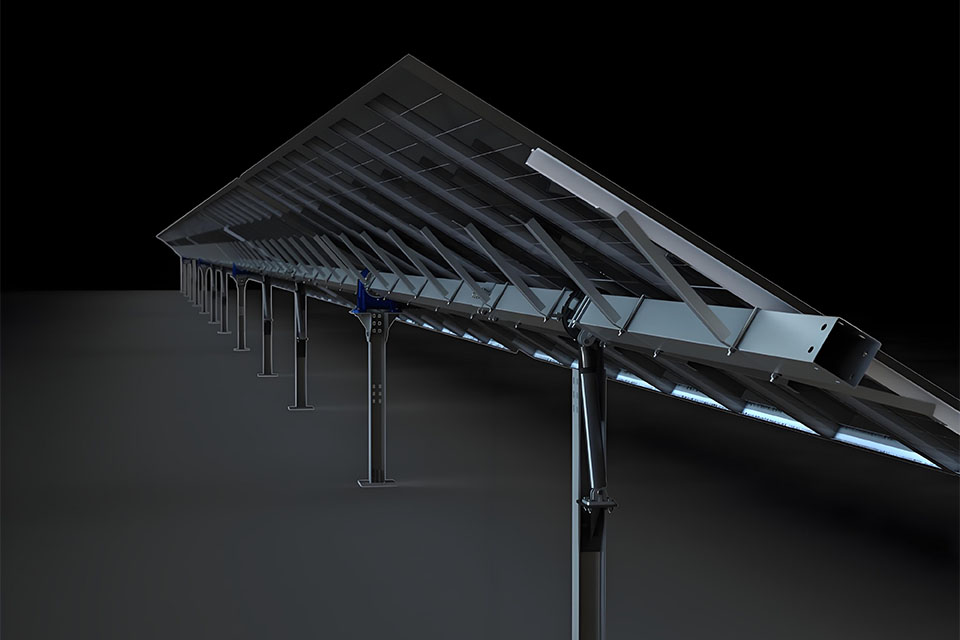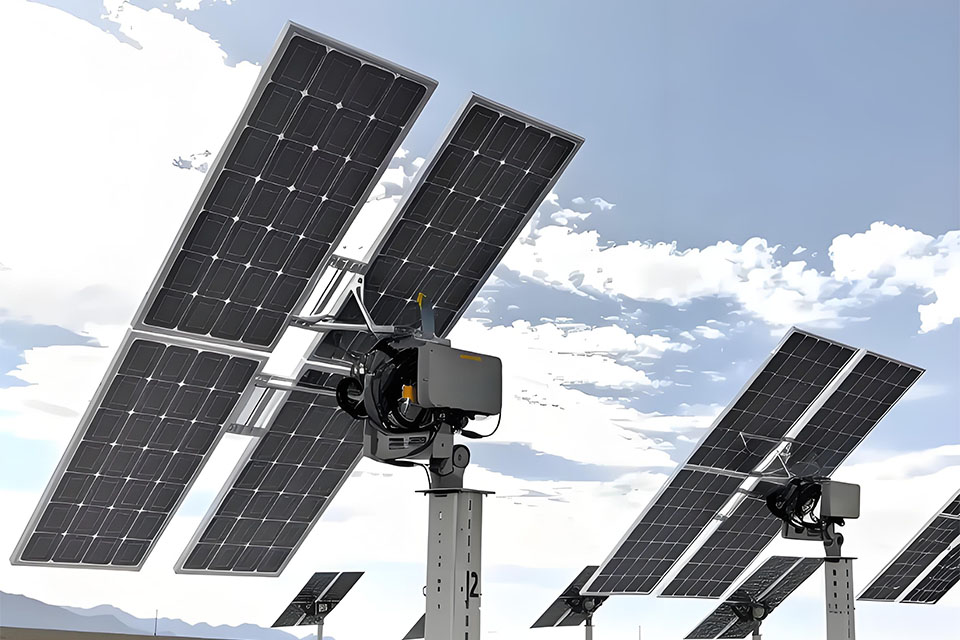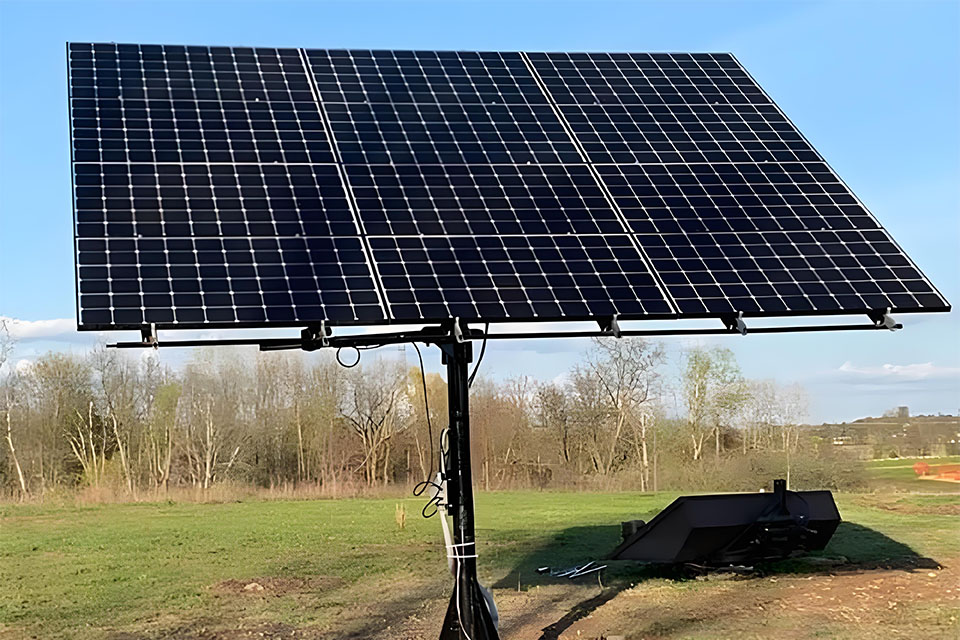Les ranchs solaires ne gagnent pas sur les seuls panneaux. Il faut un environnement complet qui transforme l'ensoleillement en mégawattheures bancables de manière uniforme et contrôlée. Les suiveurs sont au cœur de cette histoire. Ils orientent vos composants vers la lumière du soleil, développent les contours de fabrication et vous aident à atteindre les objectifs de LCOE avec beaucoup moins de risques.
Nous allons cartographier l'environnement, mesurer où les trackers déplacent l'aiguille et vous révéler exactement comment SolPath fait la différence dans des emplois réels.

L'importance des suiveurs dans l'écosystème photovoltaïque
Vous développez des installations photovoltaïques pour fournir une énergie prévisible à moindre coût. Les réseaux à inclinaison fixe laissent de la puissance sur la table. Les suiveurs à axe unique permettent d'augmenter le rendement de 15 à 25% par rapport à une inclinaison fixe. Les systèmes à deux axes peuvent augmenter ce rendement en fonction de la latitude et de l'application. Ces gains réduisent le LCOE selon des normes indépendantes et améliorent les profils de résultats respectueux du réseau qui minimisent les inconvénients de la réduction.
Lorsque votre format utilise un retour en arrière intelligent pour éviter les pertes d'ombrage d'une rangée à l'autre, vous obtenez encore plus d'énergie internet sans élargir le territoire ni surestimer la capacité de courant continu. C'est le levier que vous pouvez tirer aujourd'hui.

Les principaux éléments d'une centrale solaire moderne
Modules photovoltaïques : Les producteurs d'électricité
- Le silicium monocristallin et polycristallin permet de contrôler l'échelle des services publics. Les modules bifaciaux permettent de réaliser des gains sur la face arrière des suiveurs avec un meilleur albédo au sol.
- Les pérovskites et les films minces sont prometteurs, mais les entreprises de services publics bancables préfèrent encore les composants cristallins pour des raisons de fiabilité et de garanties.
- Les centrales électriques utilisent des onduleurs principaux ou des onduleurs de chaîne de grande puissance. Les deux se connectent directement au système SCADA de l'usine pour plus d'efficacité et de conformité.
- Les onduleurs avancés prennent en charge le maintien de la tension, la puissance réactive et la réaction de réduction. Les suiveurs aident à lisser la capture de l'irradiation, ce qui favorise la charge de l'onduleur.
- Les structures de montage, les suiveurs, le câblage, les boîtes de raccordement, l'appareillage de commutation et les sécurités assurent la circulation de l'énergie en toute sécurité.
- Les trackers remplacent les rayonnages réparés par des actionneurs, des contrôleurs et des mécanismes d'entraînement pour suivre le soleil tout en se rangeant en toute sécurité en cas de vent.
- Les batteries Li-ion et les batteries à flux modifient la valeur de l'installation. Les suiveurs alimentent l'ESS en kWh supplémentaires par heure chaude, ce qui améliore l'économie de l'aller-retour et les solutions pour le réseau.
- Le système SCADA intègre les compteurs, les terminaux météorologiques, les onduleurs et les contrôleurs de trackers. Vous détectez rapidement les performances insuffisantes. Vous nommez beaucoup plus rapidement avec des dispositifs à distance. Vous minimisez les déplacements de camions pendant les opérations de maintenance et d'entretien.
Onduleurs : CC vers climatiseur avec technique de réseau
L'équilibre du système : Le fondement méconnu
Stockage d'énergie (ESS) : Flexibilité et bénéfices
Contrôle et surveillance : Les données sont votre avantage
La place des traqueurs : Le rôle stratégique
Fonctionnement des suiveurs solaires
Les suiveurs font pivoter les rangées de composants en fonction de la course quotidienne du soleil. Les systèmes à axe unique suivent le soleil d'est en ouest, l'inclinaison étant renforcée par la latitude du site web. Les systèmes à deux axes comprennent l'inclinaison verticale pour les cas d'utilisation de niche qui nécessitent une capture optimale ou qui détaillent les comptes hors réseau.
Les systèmes actifs utilisent des contrôleurs, des moteurs et des capteurs. Des algorithmes intelligents calculent le placement avec des conceptions astronomiques. Les données météorologiques, les systèmes d'alarme de vent et la vérification des rangs alimentent la logique de contrôle. Les algorithmes de retour en arrière font pivoter les rangées à des angles d'ensoleillement réduits pour éviter l'ombrage entre les rangées, ce qui garantit les rendements du matin et de la fin de l'après-midi.
Les avantages substantiels
- Rendement énergétique plus élevé. Prévoir des gains de 15 à 25% pour un axe unique par rapport à une inclinaison fixe dans la majorité des travaux d'utilité publique. Le double axe peut apporter un plus dans certaines zones géographiques.
- Réduction du LCOE. Des kWh annuels supplémentaires par rapport à des OPEX comparables réduisent le coût par MWh. Cela renforce les accords d'achat d'énergie et les techniques des fournisseurs.
- Des résultats plus fluides. Le suivi réduit les fluctuations entre les pics et les vallées au cours de la journée, ce qui facilite l'intégration du réseau et la gestion des réductions.
- La mise en service à distance minimise le temps de retour à l'énergie. Les mises à jour OTA du micrologiciel permettent aux flottes de continuer à exister sans interruption du site Web.
- Le SCADA intégré et les communications adaptables (LoRa, ZigBee, RS485) simplifient les voies d'information vers votre EMS et l'analyse dans le nuage.
- Les techniques d'arrimage au vent réduisent l'anxiété structurelle pendant les tempêtes. Les commandes tolérantes au terrain améliorent la trajectoire sur les terrains en pente ou inégaux.
- Les terrains complexes développent l'ombrage entre les rangées. En l'absence d'une forte marche arrière, la puissance de la toile est réduite et les points chauds se multiplient.
- Les climats rudes mettent la mécanique et l'électronique sous pression. Vous avez besoin de contrôleurs, de joints et d'entraînements conçus pour résister à la chaleur, à la saleté, au froid et à la neige.
- Les calendriers de construction sont serrés. La mise en service pratique fait perdre des jours et crée des disparités entre des milliers de rangées.
- Les budgets d'exploitation et d'entretien augmentent lorsque les contrôles sont fragiles. De mauvais diagnostics entraînent des changements de véhicules qui éliminent le retour sur investissement.
Attributs avancés qui modifient l'exploitation et la gestion
Risques liés aux projets que vous ne pouvez pas ignorer
Vous pouvez gérer ces risques grâce à un meilleur contrôle des traqueurs, à des données plus propres et à des opérations à distance.
Un cadre pratique : Concevoir et déployer avec des traqueurs
- Analyse du site et vérifications géotechniques
- Valider les couches de terre et choisir les types de fondations (pieux d'acier battus, piles de béton, pieux hélicoïdaux). Adapter le couple d'entraînement à la rigidité de la fondation.
- Évaluer l'inclinaison et l'ondulation du terrain. Modéliser l'ombrage entre les rangs et définir la méthode de recul par bloc.
- Conception et agencement du système
- Définir la longueur des rangs, l'espacement entre les rangs et l'élévation pour stabiliser l'utilisation du terrain, le blindage et les parcours de câblage.
- Choisir le type d'actionneur et le style d'entraînement en fonction du climat et des plans d'entretien. Valider l'alimentation électrique du contrôleur (alimentation de la climatisation, alimentation de la chaîne ou panneau indépendant plus batterie).
- Combinaison de contrôles et santé en matière de cybersécurité
- Connecter les contrôleurs de suivi au SCADA en utilisant le RS485 ou le sans fil. Sectionner les réseaux et imposer une accessibilité basée sur les rôles.
- Intégrer les stations météorologiques et les systèmes d'alarme de vent pour déclencher le raisonnement de l'arrimage. Enregistrement des événements pour la bancabilité et la conformité de la garantie.
- Construction et mise en service à distance
- Normaliser les faisceaux de câbles électriques et les formats des cartes de commande. Mettre en service les lignes à distance avec des mises à jour et des vérifications par lots.
- Valider les entrées des capteurs et les caractéristiques de rangement. Effectuer un étalonnage à rebours du lever et du coucher du soleil sur les blocs de représentation.
- O&M et optimisation continue
- Utilisez l'analyse de la flotte pour repérer les rangées hors piste ou les couples inhabituels. Appuyez sur les mises à jour OTA du micrologiciel pour améliorer les algorithmes sans temps d'arrêt.
- Aligner l'entretien préventif sur les régimes saisonniers de vent et de neige. Suivre les paramètres du calendrier mois par mois.
Pourquoi SolPath est la meilleure réponse
Nous concevons, créons et produisons des suiveurs solaires intelligents sous la marque SolPath de Jinwu Xuanhui Technology Co, Ltd. Nous couvrons l'ensemble de la chaîne d'approvisionnement : suiveurs, contrôleurs et systèmes de montage. Vous bénéficiez d'un interlocuteur unique pour la mécanique, l'électronique et l'application logicielle.
Ce qui distingue SolPath :
- Retour en arrière résistant aux ombres. Nos formules de contrôle réduisent la perte d'ombrage entre les rangs dans les surfaces complexes, ce qui augmente le rendement net et le danger esthétique des points chauds.
- Opérations à distance d'abord. La mise en service à distance vous permet d'être en ligne plus rapidement. Les mises à jour OTA du micrologiciel améliorent les habitudes de suivi et la position de protection au fil du temps.
- Alimentation et communications flexibles. Les contrôleurs peuvent être alimentés par un système de climatisation, par un réseau électrique ou par un système solaire dédié et une batterie de secours. Les options de connectivité consistent en des protocoles RS485 et sans fil pour s'adapter à votre style SCADA.
- Conçus pour répondre aux problèmes mondiaux. Nos suiveurs prennent en charge les terrains en pente et les composants bifaciaux. Les protections contre le vent et l'environnement garantissent la fiabilité dans la chaleur, la poussière, le froid et la neige.
- Des services personnalisés, abordables et sûrs. Nous adaptons les options d'entraînement, les dispositions relatives aux contrôleurs et l'installation à votre site web et à votre budget.
- Augmentation du rendement. Des études indépendantes révèlent que les suiveurs à axe unique augmentent généralement la consommation d'énergie de 15 à 25% par rapport à l'inclinaison prise en charge, en fonction de la latitude et du climat. Les systèmes à deux axes peuvent atteindre des gains plus importants dans des situations d'utilisation particulières.
- Amélioration du LCOE. Les analyses de prix internationales associent les réductions de LCOE de 5 à 10% à une bien meilleure capture de l'énergie et à l'amélioration des performances des centrales à suiveur.
- Normes et contexte de fiabilité. Les ingénieurs bancaires utilisent la norme IEC 62817 pour la qualification de la conception des trackers et les évaluations de l'intégrité. La combinaison SCADA sous des protocoles industriels standards soutient la bancabilité et les pistes d'audit.
- Disposition du contrôleur et adaptation à la communauté. Les contrôleurs de trackers SolPath prennent en charge les dispositions d'entraînement multipoints, les diagnostics à distance et la combinaison avec la surveillance de l'installation, ce qui réduit le temps d'obtention de l'énergie et l'exposition à l'exploitation et à la maintenance.
- Confirmer les fondations géotechniques et les présomptions de couple d'entraînement.
- Modéliser le blindage et établir une politique de retour en arrière ligne par ligne, bloc par bloc.
- Sélectionnez la technique d'alimentation du contrôleur (climatisation, alimentation par string, ou solaire indépendante avec batterie).
- Spécifier les communications (RS485, LoRa, ZigBee) et le mappage des informations SCADA.
- Définissez les limites d'arrimage au vent et les traitements de filtrage avec votre EPC.
- Normaliser le câblage électrique, les actionneurs et les formats d'armoires de commande par bloc.
- Mettre en service les rangées à distance et valider les alarmes, le stockage et le retour en arrière.
- Mettre en place des procédures de contrôle de la cadence et de la modification des microprogrammes OTA.
- Fixer des objectifs d'accessibilité et établir des rapports hebdomadaires de suivi du bien-être.
- Former les groupes O&M aux diagnostics, aux verrouillages sans risque et aux procédures en cas de tempête.
- Les suiveurs sont essentiels à l'environnement photovoltaïque. Ils augmentent la production d'énergie et favorisent le respect du réseau.
- Le backtracking intelligent protège le retour dans une surface compliquée, ce qui augmente le nombre de kWh bancables.
- La mise en service à distance et les microprogrammes OTA réduisent le temps de retour à l'énergie et les frais d'exploitation et de maintenance.
- SolPath couvre les trackers, les contrôleurs et l'installation, ce qui simplifie la distribution et l'assistance.
- Conçu dans le contexte de la norme IEC 62817 et intégré au système SCADA pour des procédures fiables et des pistes d'audit propres.
- Découvrez les suiveurs solaires intelligents conçus pour les services publics : Suivi de l'échelle des services publics
- Voir notre suivi et nos pièces détachées résistantes à l'ombre : Composants du tracker
- Accélérer la nomination et améliorer le fonctionnement et l'entretien : Installation et maintenance
- Comparez les modèles à axe unique pour les projets commerciaux : Single Axis-64P : Système de suivi à axe unique à 64 panneaux
- Apprenez à connaître les contrôleurs intelligents et les mises à jour OTA : Tracker intelligent
- Fiche technique de la série de suiveurs solaires SolPath (HYP-HYX-HYS). pdf.md. ID de la base de données : 658d9b16-dc9d-46ff-8c7b-bfd95b457c8a.
- SolPath Photovoltaic Tracking Controller Series Product Introduction (AC-DC-String-Multi-Point Drive). pdf.md. ID de la base de connaissances : bfc87165-fd7b-44eb-bc73-0684426caff6.
- Manuel du produit SolPath Solar Tracker (Single & Dual Axis). pdf.md. ID de la base de données : 892a0c52-c6bd-497e-8941-84aec225ffe0.
- NREL. Radar solaire et effets de performance. Vue d'ensemble du marché à l'adresse suivante https://www.nrel.gov/.
- IRENA. Coûts de production d'énergie renouvelable en 2023. https://www.irena.org/
- IEC 62817. Qualification du style des suiveurs solaires. Commission électrotechnique internationale.
Une preuve que vous pouvez apporter à la banque
Comparaison : Fixed-Tilt vs Single-Axis vs Dual-Axis
| System Type | Rendement énergétique par rapport à l'inclinaison fixe | CAPEX | OPEX | Terrain Tolerance | Best Use Case |
|---|---|---|---|---|---|
| Fixed-Tilt | Ligne de base | Le plus bas | Le plus bas | Haut | Sites étroits, vents très forts, CAPEX très bas |
| Single-Axis Tracker | +15-25% typique | Modéré | Modéré | Haut avec backtracking | Utilité à l'échelle, latitudes larges, LCOE équilibré |
| Dual-Axis Tracker | Augmentation dans certaines zones géographiques | Higher | Higher | Modéré | Sites de niche nécessitant un captage maximal ou profils hors réseau |
Notes : Les variétés de rendement montrent les résultats normaux de l'industrie. Les gains réels dépendent de la latitude, de l'albédo, de l'ombrage et de la disposition des plantes.
Liste de contrôle pour le déploiement : Les traqueurs dans les règles de l'art

L'expérience du monde réel : Ce que vous verrez sur place
Sur les terrains en pente, vous verrez les décalages entre les rangs changer rapidement lorsque l'angle d'ensoleillement est faible. Le retour en arrière résistant à l'ombre empêche l'ombrage de la première rangée de nuire à votre résultat net. Dans les zones arides, vous devez lutter contre la poussière et la chaleur qui endommagent les joints d'étanchéité des actionneurs et les dispositifs électroniques des contrôleurs. La mise en service à distance permet à votre groupe de mettre en ligne des milliers de rangées à partir d'un espace de contrôle. Les mises à jour OTA permettent d'adapter les algorithmes aux conditions météorologiques locales sans avoir à faire rouler un véhicule.
Dans les climats froids, les épisodes de neige déclenchent un raisonnement de rangement et de redémarrage. Les contrôleurs doivent enregistrer les événements et les positions pour la garantie et la conformité. En cas de réduction, il faut un contrôle prévisible et une récupération en douceur pour que les onduleurs ne se déclenchent pas. Les suiveurs aident à maintenir la capture de l'irradiation constante, ce qui permet de conserver les habitudes des plantes.
Appel à l'action : Réduire les LCOE grâce à des suiveurs qui réfléchissent
Si vous préparez une centrale photovoltaïque à grande échelle ou si vous réalimentez un site présentant des problèmes de blindage et de surface, nous pouvons vous aider. Envoyez-nous le format de votre site et l'espacement entre les rangées. Nous vous fournirons un plan de conception et de contrôle du tracker avec un backtracking résistant aux ombres, une nomination à distance et une préparation à l'OTA.
Key Takeaways
FAQ
Les suiveurs solaires valent-ils le prix supplémentaire ?
Pour de nombreux sites d'utilité publique, les suiveurs à axe unique fournissent 15 à 25% d'énergie en plus de l'inclinaison prise en charge, ce qui réduit fréquemment le coût total de possession (LCOE). La situation se renforce aux latitudes moyennes et sur les sites où les commandes de rétrocontrôle peuvent éviter les pertes de blindage.
Quels sont les besoins de maintenance des suiveurs ?
Stratégie d'examen préventif des actionneurs, des entraînements et des unités de contrôle. Utiliser les diagnostics SCADA pour détecter rapidement les rangs qui ne sont pas sur la bonne voie. Les mises à jour OTA du micrologiciel améliorent la logique de contrôle sans site web, ce qui réduit les coûts d'exploitation et de maintenance.
Un parc solaire existant peut-il être équipé de suiveurs ?
Les rénovations fonctionnent lorsque les fondations, le câblage et la conception des onduleurs peuvent supporter la mécanique et le contrôle des suiveurs. Une étude sur l'ombrage et la géotechnique confirmera la faisabilité. La désignation à distance simplifie les coupures progressives.
Comment les suiveurs prennent-ils en charge le vent et les tempêtes ?
Les contrôleurs utilisent des alarmes de vent pour provoquer un arrimage en fonction des limites fixées. Les moteurs se déplacent vers un angle sûr pour réduire les lots. Les journaux d'événements soutiennent les procédures de conformité et de garantie.
Les trackers s'intègrent-ils au SCADA et à l'EMS ?
Oui. Les contrôleurs sont reliés par RS485 ou par des liaisons sans fil. Les usines transmettent les données relatives à l'état, aux alarmes et au placement au système SCADA, qui assure la surveillance en temps réel et l'analyse de l'efficacité.